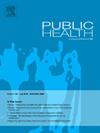COVID-19疫苗接种健康素养问卷(CVHL-Q):根据经典心理测量和Rasch分析设计和验证
IF 3.9
3区 医学
Q1 PUBLIC, ENVIRONMENTAL & OCCUPATIONAL HEALTH
引用次数: 0
摘要
目的采用经典测试理论(CTT)和Rasch测量分析对西班牙普通人群的COVID-19疫苗接种健康素养问卷(CVHL-Q)进行描述,并对其心理测量特性进行检验。研究设计于2022年2月在西班牙普通人群中进行了一项横断面观察性研究。方法对全国代表性的1067名18岁及以上的人进行在线调查。为了测量COVID-19疫苗接种健康素养(CVHL),研究小组开发了一份简短的问卷。使用Rasch分析和CTT对CVHL-Q的心理测量特性进行了探索,并遵循了评估量表验证的推荐实践。结果CVHL指数平均值为34.3 (SD: 11.6,范围:0-50),39.7%的参与者对COVID-19疫苗的识字率有限(得分≤33分)。仪器显示出令人满意的内部一致性。在判别效度方面,并非所有先验假设都得到证实:年龄越小的个体CVHL-Q得分越低,且与教育水平无关。基于300名参与者的随机子样本的最终模型显示出与Rasch模型的良好拟合(χ2 = 31.9,经Benferroni校正后p = 0.044)和令人满意的信度(PSI = 0.718)。所有项目显示有序阈值和可接受的剩余拟合。CVHL-Q是一份简短的问卷,具有稳健的测量特性,可用于评估人群查找、理解、使用和评估COVID-19疫苗信息的能力。它可能有助于设计宣传运动和评估大流行病的防范工作。本文章由计算机程序翻译,如有差异,请以英文原文为准。
The COVID-19 vaccination health literacy questionnaire (CVHL-Q): Design and validation according to classic psychometric and Rasch analyses
Objectives
This study aimed to describe the COVID-19 vaccination health literacy questionnaire (CVHL-Q) and test its psychometric properties in the Spanish general population using Classic Test Theory (CTT) and Rasch measurement analysis.
Study design
A cross-sectional, observational study was conducted among the Spanish general population in February 2022.
Methods
An online survey was administered to a nationally representative sample of 1067 people aged 18 years or older. To measure COVID-19 Vaccination Health Literacy (CVHL) a short questionnaire was developed by the research team. The psychometric properties of the CVHL-Q were explored using Rasch analysis and CTT, following recommended practices for validation of rating scales.
Results
The CVHL index mean was 34.3 (SD: 11.6, range: 0–50) with 39.7 % of participants showing limited COVID-19 vaccine literacy (score ≤33 points). The instrument exhibited satisfactory internal consistency. Regarding discriminative validity, not all the a-priori hypotheses were confirmed: younger individuals had lower CVHL-Q scores, and no association was found with education level. A final model based on a random subsample of 300 participants showed a good fit to the Rasch model (χ2 = 31.9, p = 0.044 with Benferroni correction) and satisfactory reliability (PSI = 0.718). All items displayed ordered thresholds and acceptable residual fit.
Conclusions
The CVHL-Q is a short, questionnaire with robust measurement properties that allow assessing the ability of population to find, understand, use and appraise the information on COVID-19 vaccines. It might be useful in designing communication campaigns and to assess pandemic preparedness.
求助全文
通过发布文献求助,成功后即可免费获取论文全文。
去求助
来源期刊

Public Health
医学-公共卫生、环境卫生与职业卫生
CiteScore
7.60
自引率
0.00%
发文量
280
审稿时长
37 days
期刊介绍:
Public Health is an international, multidisciplinary peer-reviewed journal. It publishes original papers, reviews and short reports on all aspects of the science, philosophy, and practice of public health.
 求助内容:
求助内容: 应助结果提醒方式:
应助结果提醒方式:


